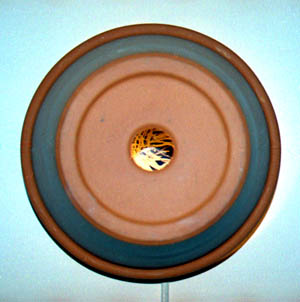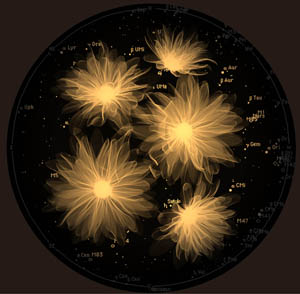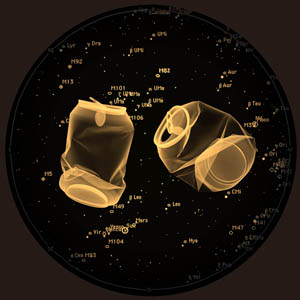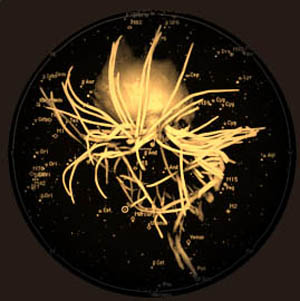
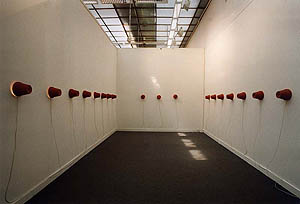
Art Moscow Workshops, 2001
View of installation
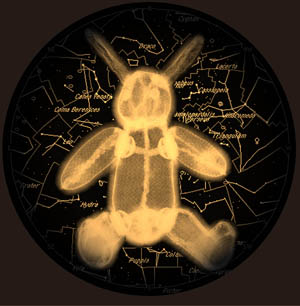
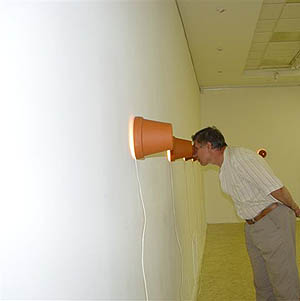
ARKA gallery, Vladivostok
View of installation
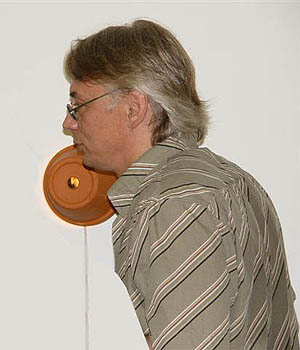
ARKA gallery, Vladivostok
View of installation
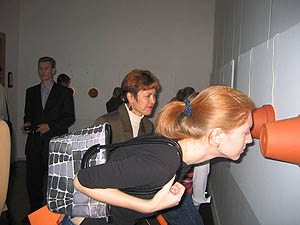
Novosibirsk Art Museum, Novosibirsk
View of installation
Tops&Roots
2001
objects/light-boxes
This project was represented at Art Moscow Workshops in 2001; ARKA gellery, Vladivostok, July 27 - September 5, 2004; Novosibirsk Art Museum, Novosibirsk, September 30 - October 30, 2004; "Die Abteilung (Workshop). Art of Technologies, cultural and exhibition center GALILEI, Moscow, 27.06-17.07.2007
Dark space. At eye level there's a straight row of crocks spotlit from within that cast even circles on the wall like flying saucers. A kind of illuminators containing black&white pictures inside. The images are seen through the peephole in the bottom of each of the “light-boxes”. The snoop game of looking thorough this telescope/microscope involve in. Sergey Shutov as always makes his spectators to fail words meanwhile imparting them a real artistic experience.
One can compose a real saga about the artist Sergey Shutov, but even the bare facts of his biography are quite impressive. Here paintings and graphics are closely related with cinema, music and new media.
The actor and art director of Sergey Soloviev's motion picture ASSA (1987), one of the leaders of the “new wave” art, the participant of Moscow Sotheby's auction (1988), the invitee misician of Sergey Kurekhin's Popular Mechanic assembly, the initiator of Brian Ino's The Shutov Assembly album (1992), the founder of the Institute of Art Technology (1993), front-liner of PTYUCH club (1994-1997), DJ at Radio Station (1995), the exponent of the Russian Pavilion at the 49-th Venice Biennial (2001), nominee of the Prize of the state of the Russian Federation (2002) etc.
Shutov has already secured of himself such titles as “pioneer of Russian video-art” (Irina Koulik), “guru of electronic art” and “prominent figure of club culture” (Nikita Alexeyev). At the same time he still remains one of the most enigmatic figures at the Russian art scene. His artworks are hardly explicable by means of any art discourse tools as well as they are hardly related with one of the art movement. They fortunately turn out to be something more than common theoretical constructions. Moreover they possess a scarce quality: they can go without comments. Thus his installation “Abacus” at the Venice Biennial (2001) didn't require any artist or curator's explanations to become one of the evident favorites of public and authorites' jury. As if Shutov possess some secret strings and his art pieces offer exact and subtle message being a product of customary high standart of the so-called “art quality”.
Sergey Shutov work is marked by multi-purpose nature (we can recall here the great Titans of the past). He makes traditional paintings and complicated media installations with the equal success. He aspires to impart his artworks the integrity of his own life and poses ahead deliberately paradoxical problems. For example, he aims to combine on the wall surface quasi alternative artisctic media: painting and video (“Carpet-Hydrangea” exhibition at the Tretyakov Gallery, 2003). Or he resolves one after another the traditional painting genres such as landscape, portrait or still life. He is constantly involved in many subjects like aviation and astronomy, botanics and ethnography, poetry and classical music or alchemy and occult sciences.
Sergey Shutov complains he didn't become a system biologist however his artistic systems demonstrate genuine complete and fascinating picture of the world. Thus the installation under pseudo-biological title “Tops&roots” serves as a new version of Ranaissance (Theosophy?) philosophy of microcosm and macrocosm. The artist places both the worlds inside of the crock and this gesture is not accidental as many antient myphologies treat the loam as the material of the divine creation. The same crock with the celestial map image on its sides is known as one of the most antient calendars at the European continent. And here the celestial map (one of the most majestic pictures that the humankind ever knew) serves as the background for the images of other kind. The last ones are roots' enalrgements and animals and objects' roentgenograms, they represent the microcosm and take the place of a man. The viewer is immediately tempted to read the meaning in a literal sense (for example, the convenient antithesis: roots – stars), but in the middle of the row he reveals the Jolly Roger's roentgenogram or a sqweesed can and a bunch of keys. The artist seems to spoil the game taking the most common and vain creatures as personifications of the “little world” whether advisedly destroying the antient cosmic unity of “micro” and “macro” or raising it to the superior extent…
Thus the muteness comes and probably here the true art begins.
Sergey Shutov remembers his visit to the Moscow Planetarium as one of the most powerful impressions of his childhood. He recalls the moment when the celestial dome becomes illuminated by the rays of the rising sun and the shape of the dwellings below becomes distinct. “And if all the Earth begins from the Kremlin, the Sun is getting rised at Vladivostok”, - the erudite artist notes.
(Ekaterina Lazareva)
